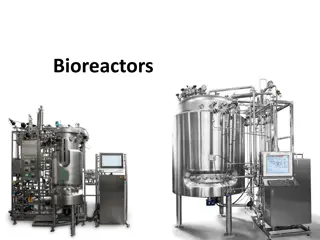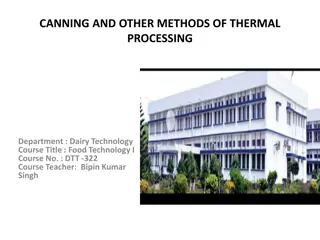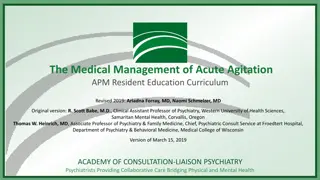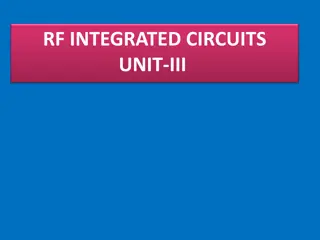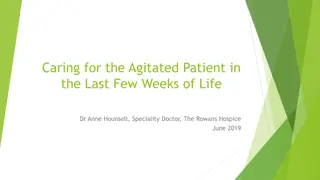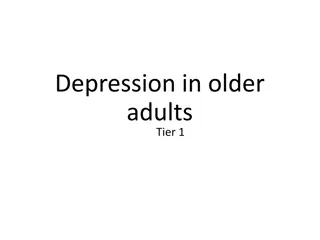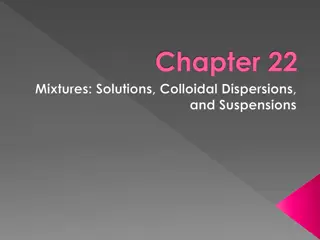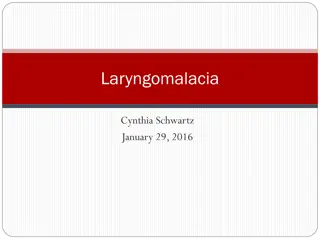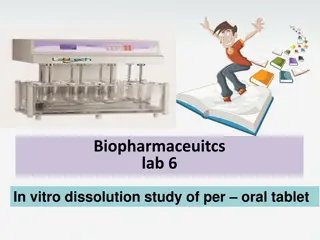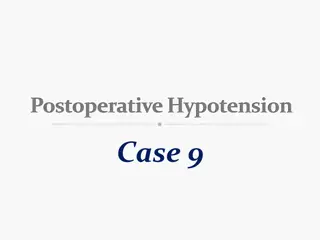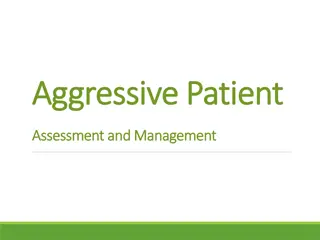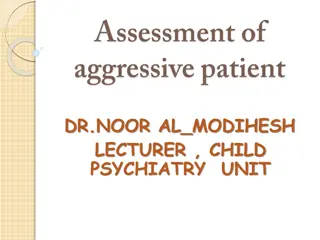Appropriate use of antipsychotics for changed behaviours in people living with dementia
Dementia is characterized by various changes, including behaviours such as wandering, disinhibition, agitation, and aggression. People living with dementia require care that can be approached through non-pharmacological and pharmacological strategies. The overreliance on psychotropic medications lik
0 views • 25 slides
Understanding Bioreactors: Components and Functions
Bioreactors are essential vessels used for the production of various chemicals and biological reactions. They provide controlled conditions for fermentation processes, including agitation, aeration, temperature, and pH control. Key components such as fermenter vessels, heating, cooling apparatus, an
10 views • 16 slides
Thermal Processing in Food Technology: Canning and More
Canning is a method of sealing and sterilizing food in containers for long-term storage. It involves processes like can filling, lacquering, syruping, brining, exhausting, processing, and cooling. Factors influencing heat penetration rates include product type, container size, and agitation. This de
0 views • 8 slides
Understanding and Managing Acute Agitation in Medical Settings
This resource discusses the medical management of acute agitation, covering the behavioral spectrum, differential diagnosis, non-pharmacologic and pharmacologic approaches, and case scenarios. Definitions of agitation, aggression, and violence are provided along with descriptions of component behavi
0 views • 68 slides
Understanding Noise in RF Integrated Circuits: Thermal and 1/f Noise
Noise, an unwanted input, limits a system's ability to process weak signals. Sources of noise include random noise in resistors and transistors, mixer noise, undesired cross-coupling noise, and power supply noise. Thermal noise, caused by thermal agitation of charge carriers, is also known as Johnso
1 views • 49 slides
Managing Agitation in Patients in End-of-Life Care
Understanding and managing agitation in patients during the final weeks of life is crucial for providing comfort and support. This presentation by Dr. Anne Hounsell covers key aspects such as defining agitation, identifying causes, assessing reversible factors, and implementing non-pharmacological i
0 views • 17 slides
Understanding Depression in Older Adults
Depression in older adults is not a normal part of aging and should not be ignored. Recognizing the signs and symptoms, such as disturbed sleep, lack of interest, and thoughts of self-harm, is crucial in detecting and addressing this condition. Presentation of depression may include agitation and pe
1 views • 13 slides
Understanding Depression in Older Adults
Depression in older adults is not a normal part of aging and should not be ignored. It is characterized by a group of signs and symptoms, including depressed mood, disturbed sleep, lack of enjoyment, reduced energy levels, and thoughts of self-harm. Older adults may present with different symptoms s
0 views • 22 slides
Vocabulary Enrichment with Visual Aid
Enhance your vocabulary with visual representations of words like "flippant," "culminate," "prolific," "agitation," "animosity," "transgressor," "benign," and "pensive." Each word is paired with its definition and antonyms, making learning engaging and effective.
0 views • 9 slides
Understanding Mixtures: Solutions, Colloidal Dispersions, and Suspensions
Food mixtures can be classified based on particle size distribution, with the dispersed phase scattered throughout a continuous medium. Solutions, a type of mixture, consist of a solute (dispersed phase) and a solvent (continuous phase), forming a homogenous blend. Factors like temperature, particle
0 views • 80 slides
Laryngomalacia: Causes, Symptoms, and Management
Laryngomalacia is a condition characterized by the inward collapse of supraglottic structures during inspiration, leading to intermittent airflow obstruction. It is a common cause of neonatal and childhood stridor, with symptoms typically appearing within a few weeks after birth. The condition can b
0 views • 16 slides
In Vitro Dissolution Study of Per Oral Tablet: Understanding Drug Absorption
Dissolution is a crucial process for drug absorption, where solid dosage forms must dissolve in gastrointestinal fluid before absorption. Factors affecting dissolution rate include agitation intensity, drug solubility, and surface area exposed to the dissolution medium. Dissolution testing plays a k
0 views • 12 slides
Postoperative Hypotension: Management and Recovery Strategies
In a case of postoperative hypotension following a transurethral prostatectomy under spinal anesthesia, a 78-year-old patient presented with agitation and shivering in the PACU. Vital signs and pain scores were monitored, showing a blood pressure of 89/40, heart rate of 85/min, and respiratory rate
0 views • 16 slides
Understanding Agitation and Aggression in Psychiatric Patients
Agitation is a tension state characterized by anxiety and hyperactivity seen in depression, schizophrenia, and mania, while aggression involves hostile thoughts or actions towards others, common in impulse control disorders. Psychiatric patients are usually not aggressive, but certain mental illness
0 views • 16 slides
Understanding the Difference Between Aggression and Agitation in Psychiatry
Aggression involves verbal or physical attacks, while agitation is a state of mental disturbance leading to physical restlessness and increased arousal. Both can be common presentations in psychiatric emergencies with various risk factors and management strategies involved, including verbal communic
0 views • 14 slides

